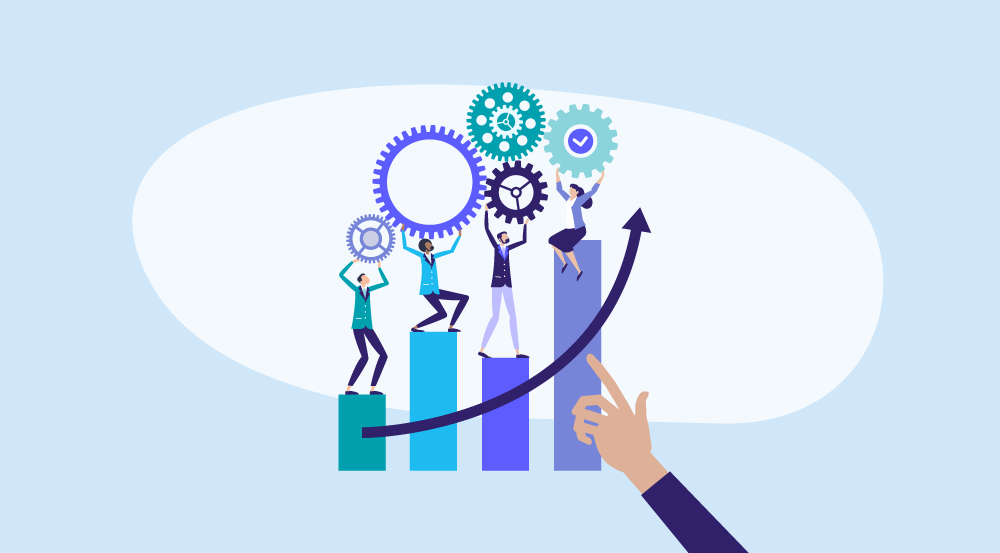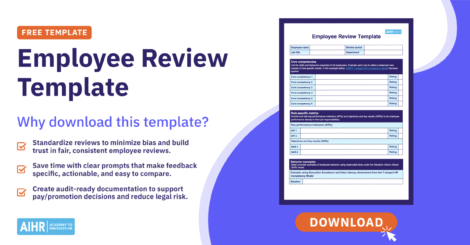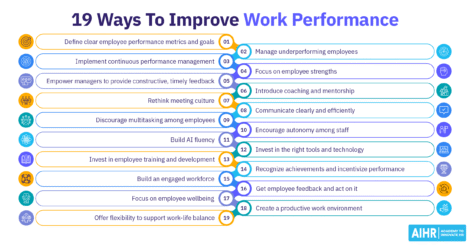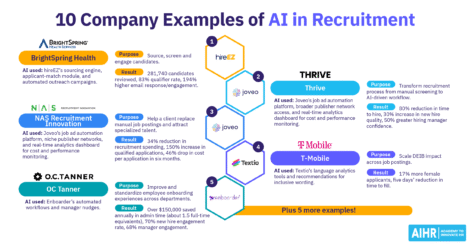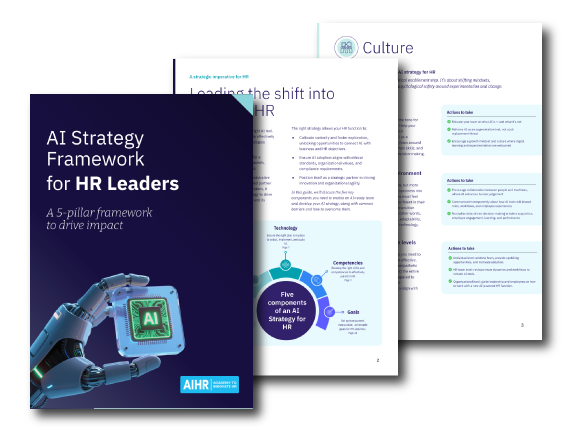Improving work performance starts with creating an environment where people can thrive. That means setting clear expectations and goals, providing useful feedback, giving managers the right tools, and building a culture that values development. When these factors come together, work performance improves across the organization.
This article explores the impact of employee performance on business results, 19 practical ways you can help improve work performance at your organization, and real-life examples from successful businesses to inspire you.
Contents
How work performance impacts business performance
19 practical ways to improve work performance
– Performance goals and accountability
– Manager enablement, feedback and coaching
– Collaboration and work practices
– Skills, tools and AI
– Culture, recognition and engagement
– Wellbeing, flexibility and environment
Key takeaways
- To improve work performance at your organization, set clear, aligned goals and use continuous performance management to drive productivity and accountability.
- Equip employees with skills, tools, and AI fluency to cut “work about work” and focus on high-value tasks.
- Strengthen manager practices (e.g., constructive feedback, coaching, and strengths-based development) to lift individual and team performance.
- Invest in culture levers, such as engagement, recognition, wellbeing, flexibility, and focus-friendly environments, to boost retention, morale and results.
How work performance impacts business performance
Strong work performance centers on employees meeting organizational goals, which vary from one company to another. For example, some organizations may base performance level on output, some on specific KPIs, and others on innovation metrics.
When staff perform well, they’re more productive and satisfied. Teams also benefit from higher morale, better use of resources, improved customer outcomes, and increased revenue. High-performing cultures can also attract top talent and reduce turnover. In short, employee performance directly impacts business success.
19 practical ways to improve work performance
Below are 19 practical ways you can help improve performance at your organization, classified into six helpful categories:
Performance goals and accountability
1. Define clear employee performance metrics and goals
Set clear, aligned goals for every role and measure progress with simple employee performance metrics (e.g., work efficiency or NPS). Additionally, tie individual SMART goals to company priorities, so people know what success looks like and where they stand. Clear goals motivate, create visibility, and drive accountability.
Real-life example: Google aligns teams with OKRs (objectives and key results), i.e., ambitious, measurable goals that are public and scored. This pushes focus on “big bets” and transparent progress tracking across the company.
2. Manage underperforming employees
Ensure you’re managing underperforming employees well. Meet with each underperforming employee, restate expectations, and agree on a short, specific action plan. Then, check in regularly, give direct feedback, and recognize improvements. This will help keep work on track and improve team results.
Real-life example: Netflix refreshed its culture memo to emphasize candid assessment and talent density. It reiterated its “team, not family” stance, and the keeper-test ethos that managers should fight to keep top performers and let underperformers go.
3. Implement continuous performance management
Replace annual appraisals with continuous performance management, which requires frequent, structured check-ins. Ongoing conversations reveal issues early, provide real-time feedback, and help teams adapt to change. They also strengthen manager–employee relationships and support continuous growth.
Real-life example: Adobe replaced annual reviews with ongoing ‘check-in’ conversations focused on expectations, feedback and growth. The program features toolkits and FAQ that describe how managers and employees set goals and revisit them frequently throughout the year.
Manager enablement, feedback and coaching
4. Focus on employee strengths
Play to each employee’s strengths by identifying what each person does best, and designing work that allows them to use those strengths more often. Employees who use their strengths daily are more likely to be engaged, perform better, and stay longer at the company. Try using the CliftonStrengths assessment to help you in this area.
Real-life example: Gallup’s 2024 Don Clifton Strengths-Based Culture Award highlighted companies operationalizing CliftonStrengths to boost engagement and results. Stryker, which won for the fifth year in a row, showed how centering strengths at work could sustain performance.
5. Empower managers to provide constructive, timely feedback
Train managers to deliver timely, detailed narrative-only feedback linked to specific outcomes. They should balance what went well with what needs improvement, and make the next steps clear. Additionally, schedule regular one-on-one meetings to ensure consistent, actionable guidance.
Real-life example: McKinsey describes feedback as the “fuel” of a performance culture and promotes frequent, specific, actionable input tied to real work, reinforcing manager habits that normalize candid coaching and rapid course-correction.
6. Introduce coaching and mentorship
Build coaching and mentoring into the cadence. Pair senior and junior employees — including cross-function matches — to share know-how, expand networks, and build confidence. Coaching skills also make managers better leaders.
Real-life example: Randstad’s structured mentoring reduced attrition by 49% among participants, demonstrating how formal matching and program governance can convert coaching time into measurable retention and performance gains.
Boost work performance with better talent practices
Improving and managing employee performance effectively requires a clear talent strategy, development opportunities, and systems that support growth at every level.
🎓 AIHR’s Talent Management & Succession Planning Certificate Program will help you:
✅ Develop strategies to engage and retain employees
✅ Use data and talent reviews to guide better decision-making
✅ Take a proactive approach to succession planning to strengthen your talent pipeline
✅ Build an organizational culture that supports business goals.
Collaboration and work practices
7. Rethink meeting culture
Fix meeting bloat by requiring a purpose and agenda for each meeting, setting clear outcomes, inviting only needed participants, and ending with owners and deadlines. At the same time, give employees permission to decline low-priority meetings, so they can focus on more important work.
Real-life example: Slack implemented meeting-free Focus Fridays and Maker Weeks, with the former involving cancelling internal meetings and disabling notifications for uninterrupted focus time. During Maker Weeks, teams cancel recurring internal meetings to focus on creating (e.g., coding, writing or planning).
8. Communicate clearly and efficiently
80% of employees say the communication practices in their organizations are poor or, at best, average. As such, it’s important to communicate with clear intent. Managers must clarify responsibilities, priorities, and upcoming changes, and confirm that their teams understand them. Simple, concise messages can reduce rework and improve teamwork.
Real-life example: Amazon’s “working backwards” makes teams write a customer-facing press release and FAQ before building, promoting clear problem definition, benefits, and success metrics upfront. This surfaces risks early and cuts rework, with six-page narratives reinforcing precise thinking and faster execution.
9. Discourage multitasking among employees
Research has shown that the human brain can only focus fully on one thing at a time, meaning multitasking affects performance. As such, you must discourage employees from multitasking. Ask them to work on one task at a time, in order of priority, until they complete each one. This reduces context-switching and raises work quality.
Real-life example: Microsoft Viva Insights automatically books Focus time, silences notifications, and sets status to protect uninterrupted work blocks. This helps employees create daily focus plans and cut context-switching, in turn boosting productivity and performance.
10. Encourage autonomy among staff
Micromanagement harms morale and work performance. One of the most crucial skills a manager can have is delegating with trust and confidence, encouraging autonomy in the workplace. Tracking goals, establishing a clear line of communication, and offering comprehensive continuous feedback can help to build that trust on both sides.
Real-life example: Spotify’s autonomy-with-alignment model gives small cross-functional squads latitude within lightweight structures (tribes/chapters). This allows teams to choose suitable methods while staying aligned on shared goals.
Skills, tools and AI
11. Build AI fluency
Research shows AI-fluent employees perform better at work — 81% are more productive, 54% more creative, and 53% more prepared to solve complex business challenges. As such, it’s important to build AI fluency through hands-on use. Give employees time, guidance, and safe use cases, so they can practice with copilots and automation.
Real-life example: PwC became OpenAI’s first ChatGPT Enterprise reseller and the product’s largest user. This meant it provided access to more than 100,000 employees while investing $1 billion in GenAI capabilities, pairing tooling with at-scale enablement.
12. Invest in the right tools and technology
Access to the tools and technology needed to complete work efficiently can help boost productivity and performance. Be sure to equip staff with the right tools and ergonomic setups. Ensure hardware, software and workflows remove friction (at home and in the workplace), so work is fast, accessible and reliable.
Real-life example: As an all-remote company, GitLab keeps a continuously updated handbook that funds home office setups and codifies tool usage and processes. This helps reduce friction, and makes distributed work fast and reliable.
13. Invest in employee training and development
86% of employees find training important, and 59% say it improves their performance. Your organization must invest in training that closes real skills gaps, and offer targeted learning tied to role outcomes and career paths. Practical learning and development (L&D) programs help improve performance and motivation, ultimately increasing business success and enhancing the employee retention rate.
Real-life example: AT&T’s multi-year, $1 billion Future Ready reskilling program retrains its existing employees for new tech-focused roles. It aims to reskill over 100,000 staff for roles in areas like cybersecurity, data analytics and cloud computing.

Culture, recognition and engagement
14. Recognize achievements and incentivize performance
Recognize and reward good work to show staff you appreciate their contributions. This makes them feel valued and encourages good performance. Use a simple employee recognition rhythm (e.g., weekly shout-outs or monthly awards) and meaningful rewards, such as bonuses or extra time off. Public praise sets performance norms and lifts morale.
Real-life example: Eaton built a global social recognition program with Workhuman to make praise timely, visible, and locally relevant. This has led to improved engagement and retention as recognition has scaled across the enterprise.
15. Build an engaged workforce
Building an engaged workforce matters. To boost engagement, think of it as a management system. Measure it regularly, act on your findings promptly, and tie the actions you take to business outcomes. Engaged teams feel more motivated perform better and remain at the company for longer, reducing employee turnover.
Real-life example: Cisco replaced ad-hoc spot bonuses with Connected Recognition, a global tech-enabled program that lets anyone visibly recognize peers. Adoption is high, with 93% of leaders having recognized someone and 90% of employees having received recognition.
16. Get employee feedback and act on it
Organizations are more likely to perform well if their employees feel heard and valued, which typically motivates them to perform at their best. Use employee pulse surveys, open forums, and manager check-ins to gather employee feedback. Then, close the loop by explaining what you’ll change, what you won’t, and why. This builds trust and supports better performance.
Real-life example: SAP runs twice-yearly employee listening (in June and November) and uses the results — including an Employee Engagement Index tied to executive incentives — to inform actions. This shows a closed-loop approach to continuous employee listening.
Wellbeing, flexibility and environment
17. Focus on employee wellbeing
Happy, healthy people perform better at work, while those in poor physical or mental health are likely to underperform and be absent more. Promote wellbeing as a productivity driver — encourage breaks and sustainable workloads, and provide benefits like counseling. Leaders should also model healthy habits, such as not overworking.
Real-life example: HubSpot combats employee burnout signs with an annual, company-wide Global Week of Rest, so everyone disconnects at the same time and returns recharged. It complements other burnout measures (e.g., no-internal-meeting Fridays) aimed at sustaining energy and productivity.
18. Create a productive work environment
Design for deep work — set quiet-work norms, offer dedicated focus areas, allow headphones, protect calendar-blocked focus time, and keep workspaces clean and organized to reduce visual noise. For remote staff, fund a basic home office setup (e.g., chair, desk, lighting) and encouorage a defined work zone.
Real-life example: Dropbox’s Virtual First model defines non-linear workdays with core collaboration hours, async-by-default norms, and office spaces redesigned for collaboration. This has resulted in benefits like wider talent pools and improved meeting hygiene.
19. Offer flexibility to support work-life balance
When employees have more flexibility in where and when they work, they’re likely to be more engaged and satisfied with their jobs, which can improve performance. To support this, offer flexible work options where roles allow, and let teams align schedules and locations for work. This not only drives motivation but boosts your employer brand experience.
Real-life example: Atlassian’s Team Anywhere policy enables distributed work with clear guardrails and async norms. The model supports flexibility, hiring reach and focus time — all while preserving collaboration.
To sum up
Improving work performance requires consistent fundamentals. Set clear, aligned goals, and equip people with the right skills, tools and AI so they spend less time on “work about work” and more time on high-value tasks. Additionally, strengthen manager habits (e.g., specific feedback, coaching, and strengths-based development), so individuals and teams keep raising the bar.
To make it operational, pick two or three plays to start, assign owners, define simple metrics, and run a 90-day pilot. At the same time, standardize workflows, recognize wins publicly and model healthy workloads, then scale what works across teams. This will lead to higher output, better retention, and a culture that sustains performance.



